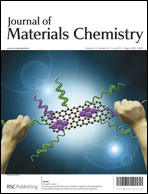In this work, an efficient approach for targeting and detecting cancer cells has been developed through the design of the assembly of fluorescent carbon nanodots and folic acid (C-dots–FA), which is endocytosible by the overexpressed folate receptor (FR) molecule. The fluorescent C-dots were prepared by a facile microwave pyrolysis method, but their surfaces were passivated with 4,7,10-trioxa-1,13-tridecanediamine, so that active amino groups could be engineered for the further conjugation with FA. The uptake of the designed C-dots–FA by HeLa cancer cells, as revealed by confocal laser scanning microscopy, is via receptor-mediated endocytosis, which is further confirmed by competition experiments as well as a comparative study with FR-negative MCF-7 cells. The proposed method shows excellent biocompatibility, and, most notably, its applicability to discriminating FR-positive cancer cells from normal cells has been successfully demonstrated by culturing and analyzing the first model cell mixture of NIH-3T3 and HeLa cells, which makes it of great potential for cancer diagnosis studies.

You have access to this article
 Please wait while we load your content...
Something went wrong. Try again?
Please wait while we load your content...
Something went wrong. Try again?


 Please wait while we load your content...
Please wait while we load your content...